

January 2013
IN THIS ISSUE:
![]()
- Commissioned Corps officers from the CC provide care to hurricane survivors
- NIH Gingerbread House Contest pulls record submissions and votes
- Data mining helps patients with certain conditions get social security support quicker
- Pediatric Consult Service chief earns NIH tenure
- Programs call on staff experience to foster others' success
- Please pardon our dust
Print this Issue ![]() (782 KB)
(782 KB)
ABOUT CC NEWS:
![]()
Published monthly for CC employees by the Office of Communications and Media Relations. News, article ideas, calendar events, letters, and photographs are welcome. Submissions may be edited.
Clinical Center News
National Institutes of Health
Building 10, 10 Center Drive
Room 12C440,
Bethesda, MD 20892-1504
Tel: 301-496-6787
Fax: 301-402-1982
PAST ISSUES:
![]()
2012
QUICK LINKS:
![]()


Stop searching on your own for clinical studies.
Let opportunities to join a study find you.
The NIH Clinical Center has joined ResearchMatch, an online, national clinical research registry that "matches" people who want to participate in clinical studies with researchers who are seeking volunteers. To learn more, visit researchmatch.org/?rm=Volunteer3
Commissioned Corps officers from the CC provide care to hurricane survivors
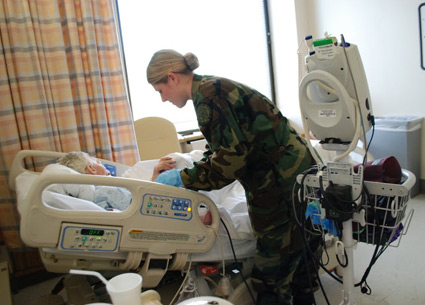 |
| LT Kelly Kerr, CC oncology nurse and Commissioned Corps officer, attended to a patient at the Brookdale University Hospital and Medical Center during the aftermath of Hurricane Sandy. |
While Hurricane Sandy shut the government down and preparations were made for a soggy Halloween in the DC region, US Public Health Service (USPHS) Commissioned Corps officers were being deployed to New York. Several officers from the Clinical Center spent weeks helping those who lost their homes and their sense of safety when the super storm struck.
Nurse consultant CDR Mike Krumlauf was one of the first emergency responders and was assigned the role of deputy chief of operations of a USPHS Rapid Deployment Team. Landing in New York City on Oct. 30, Krumlauf received orders that his unit would set up in a wing of Brookdale University Hospital and Medical Center in Brooklyn.
Brookdale graciously volunteered two floors that had been vacant for 13 years. Prior to the arrival of the USPHS officers, hospital staff had worked 36 hours straight on a very quick refurbishing: painting, updating electrical and plumbing, and readying the bedding and other amenities. Setting up the unit in a hospital wing was a new experience for the USPHS officers.
"We normally set up operations in a stadium or auditorium — a place where we can see everyone at once. Then it's easy to know who needs help," Krumlauf said. There were definite advantages to using the hospital floors: hospital beds instead of cots, the abundance of bathrooms and the benefit of using some of the hospital resources, he said.
On Nov. 1 the officers were still deep in preparation as patients started arriving. The team quickly became responsible for more than 90 patients from three nursing homes. The patients were elderly, vulnerable and some had mental disabilities requiring constant care. The upheaval and disruption to their typical routine was especially traumatic to this patient population. Used to working with a lot of uncertainty, the corps officers pulled together, providing the highest quality care and compassion, while still in survivorship mode, for the dislocated patients.
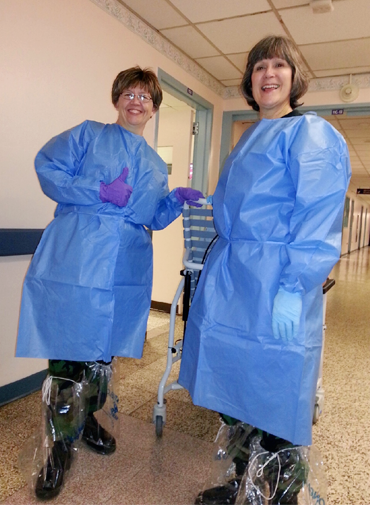 |
| LCDR Dr. Margaret Bevans (left) and LCDR Kristin Egelston (a corps officer from the Bureau of Prisons) kept spirits up while working with a high patient load during the Hurricane Sandy aftermath in Brooklyn. |
Nurses worked together as ambulances kept arriving with more patients while staffing stayed thin. The patients arrived with bags of medications, but limited medical records. Officers had to scramble to create charts and track down dosages. Nursing assistants from the nursing homes did not arrive until days after their patients, but were a welcomed complement for the deployed officers.
Further complicating matters were an additional snowstorm resulting in even more patients and the logistics of Election Day. Through a very coordinated effort everyone was able to vote through absentee ballots or electronic forms, nurse LCDR Linhua Tzeng said.
"It was hard work, but you get into a routine and just work. It was clear we were making a difference. There was so much gratitude," LCDR Dr. Margaret Bevans, clinical nurse scientist, said.
Tzeng wrote in an email to her colleagues at the CC, "We are working around the clock but everyone seems to be in good spirits… It has been a rewarding experience, and I am happy that we are providing public service to the population, as there is a great need. We are truly following our mission of protecting, promoting and advancing the health and safety of the nation."
In addition to Krumlauf, Tzeng and Bevans, CDR Rosa Clark, LTJG Frances Andrada and LT Kelly Kerr from the CC were also deployed to aid in the Hurricane Sandy response.
NIH Gingerbread House Contest
pulls record submissions and votes
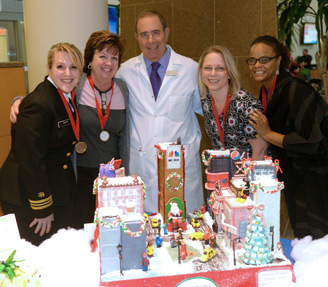 |
| Members of the Nursing Central Staffing Office celebrated their first place win with CC Director Dr. John I. Gallin. From left are Kimberly Scott, Susan Perry, Teresa Kessinger and Tonia Shuler. |
Taking first place with 635 votes was Nursing and Patient Care Services' Central Staffing Office's rendition of New York City's Time Square. Second place went to the NIH Medical Research Scholars Program's nod to Saint Basil's Cathedral in Moscow, relevant as the CC brought their clinical research curriculum to Russia in 2012. Rounding out the top three was the Lego hospital from OP11. For the second year photos of the contest submissions were posted on Facebook for users to vote for the online fan favorite. One commenter wrote of one of the gingerbread creations, "Even the great sculptor Michelangelo would have to stare and nod his head at this one." The National Institute of Mental Health's Section on Developmental Genetic Epidemiology's Nightmare Before Christmas entry won Facebook Favorite. "Every year I think they can't top the year before," said nurse manager Ann Marie Matlock, who organizes the contest. "I don't know how they do it, but there is no limit to the staff's creativity and dedication." |
The real winners of the Ninth Annual NIH Gingerbread House Contest were the more than 2,500 patients, visitors and staff who visited the house display in the Clinical Center atrium and cast a vote for their favorite.
"To those of you who put in the work to create these beautiful houses, thank you. You've brought a lot of smiles to this place," said CC Director Dr. John I. Gallin.
This year's contest brought in 35 entries, and the display coincided with a food drive for The Children's Inn.
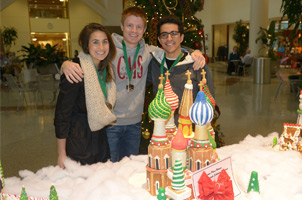 |
| Second place in the NIH Gingerbread House Contest went to the Medical Research Scholars Program (left), including, from left, Tanya Glaser, Jason Frerich and Shervin Rahimpour, for Saint Basil's Cathedral. |
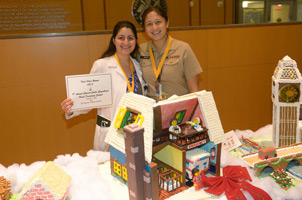 |
| The staff of OP11, including Ana Agharahimi (left) and LT Ashleigh Hussey, won third place with their Lego hospital. |
Data mining helps patients with certain conditions get social security support quicker
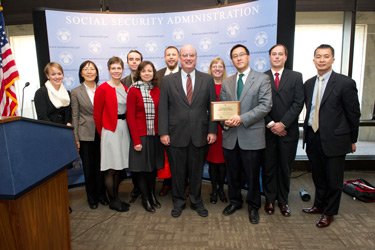 |
| Clinical Center's Rehabilitation Medicine Department's work on the Compassionate Allowances Program earned them the Commissioner's Appreciation Award from the Social Security Administration. |
The Rehabilitation Medicine Department (RMD) Epidemiology and Biostatistics Section and Chief Dr. Leighton Chan received the Commissioner's Appreciation Award from the Social Security Administration (SSA) in December. The award was in recognition of the RMD's work on the Compassionate Allowances Program (CAL), which identifies conditions and disorders that may be allowed expedited support from the SSA.
Some afflictions have a high likelihood for approved support from the SSA, but the approval process may take time when the individual could be in critical need. The CAL Program identifies minimal objective medical information that would flag such individuals for support, thereby getting them the help they need faster.
Using cutting-edge mathematical techniques, the RMD team designed an approach to systematically examine existing SSA data and make decisions about future expansion and refinement of the CAL Program. Their research found conditions not currently in the CAL Program, but with comparable survival programs to those that are. Inclusion of severe forms of cancer, liver disease, and HIV infection, and cerebral trauma in the CAL Program may help more patients in need get support faster. The RMD also prioritized conditions identified as possible CAL Program candidates based on a new measure of urgency computed from SSA data.
The data-driven methods conceptualized and implemented by the RMD will allow the SSA to to refine the CAL Program list to continue to include the most appropriate conditions as medical advances change the prognosis of diseases.
Pediatric Consult Service chief earns NIH tenure
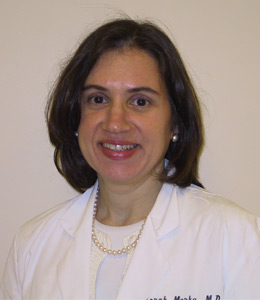 |
| Senior investigator Dr. Deborah Merke, chief of the Clinical Center Pediatric Consult Service, recently earned NIH tenure. |
Senior investigator Dr. Deborah Merke, chief of the Clinical Center Pediatric Consult Service, recently earned NIH tenure.
Merke was named service chief in 1999 after a position with the National Institute of Child Health and Human Development. She attended the University of Massachusetts and the Columbia University School of Public Health before earning her medical degree at the State University of New York at Buffalo. Merke completed a pediatric residency at the Children's Hospital of Philadelphia and a fellowship in pediatric endocrinology at the NICHD.
"My team has made significant contributions to the study of congenital adrenal hyperplasia (CAH), a group of inherited disorders of the adrenal glands," Merke said. People with CAH have problems with normal growth and development because they lack an enzyme to make the hormones cortisol and aldosterone and their adrenal glands produce excess androgenic hormones. Classic CAH, the most severe form of the disorder, is usually detected shortly after birth and can be life threatening. The milder form, nonclassic CAH, causes a variety of symptoms, including the premature development of body hair, early puberty and infertility.
Merke's team discovered that patients with CAH have adrenaline deficiency and smaller-than-normal amygdalas (the part of the brain that regulates emotion). Her research also identified problems with a common medication once used to treat CAH, leading to a product recall in the 1990s. Today, they are conducting the largest ever natural-history study of CAH, with more than 250 patients enrolled, and are studying two promising treatment approaches. One blocks excess sex steroids and aims to improve the growth and development of affected children. The other study focus is a new form of cortisol replacement designed to mimic normal cortisol secretion.
Merke and her co-researchers are also collaborating with the National Institute of Mental Health to explore the psychological aspects of hormone imbalances and with the National Institute on Aging to look at other genes that may influence CAH symptoms and their severity.
Merke is a member of the Pediatric Endocrinology Subboard of The American Board of Pediatrics, authors questions for the Pediatric Endocrinology Board Examination, and enjoys spending time with her husband and two daughters and cross-country skiing.
Programs call on staff experience to foster others' success
Clinical Center/NIH offer professional development success
Brown bag series explores essentials for success
Learn how to give and receive feedback in the first session of the 2013 Leadership Development Brown Bag Series from the Clinical Center Office of Workforce Management & Development (OWMD). The theme of this year's series is Back to the Basics: Essentials for Employee Success.
On Jan. 7 representatives from the OWMD and the NIH Office of the Ombudsman's Center for Cooperative Resolution presented on giving and receiving feedback, during performance reviews and in other situations. Look for their tips in February's CCNews.
Future brown bag sessions will focus on enhancing motivation, advanced communication skills and mindfulness in the workplace.
Call the OWMD at 301-594-9548 or visit http://intranet.cc.nih.gov/owmd/index.html for more information.
Join the NIH-HHS Mentoring Program
Federal employees interested in serving as mentors and mentees across the NIH community are invited to join the NIH Mentoring Program.
The cornerstone of the program is partnering for excellence by building a confidential, interactive relationship. The emphasis on developing core, leadership and management competencies at various levels will ensure a beneficial experience for both mentors and mentees.
This free program features:
- peer-to-peer and senior-to-junior mentoring relationships
- online application and matching system to connect individuals
- online mentor-mentee orientation
- one-year mentoring relationship commitment
- professional development events and activities
As a tool in employee development, the mentoring program does not supplant the NIH scientific mentoring and customized institute and center leadership mentoring programs. Instead, it is intended to fill any gaps those programs do not cover and enables NIH-wide or even across-HHS relationships.
Learn more at http://trainingcenter.nih.gov/HHS_Mentoring.html.
Please pardon our dust
Maintenance and renovations breed disruption
If you work in Building 10, the construction zone is a familiar sight. You may be wondering why it seems like there is always work being done. Be happy this isn't a plot meant to ruin your day, but simply the price of working in a building on the cutting edge of science.
Maintaining a building the size of the Clinical Center is a logistical challenge. Not only does routine preventive maintenance need to be done, for example, air filters must be changed and the balance of temperature and humidity has to be monitored. "Emergency" work also adds to the challenges as pipes burst, sinks overflow or a car accidentally crashes into the building. Testing the emergency generator is a Joint Commission-mandate to assure our laboratories and patient care areas don't suffer from a gap in electricity during inclement weather.
Daniel Roberts, an NIH Office of Research Facilities (ORF) facility manager assigned to Building 10, acknowledged, "All the testing and down-time is a headache for everyone, but it is essential in keeping the building safe."
While the general maintenance is an interruption to the daily flow of the CC, the effects of renovation and construction in the Magnuson Building are also frustrating for occupants. These changes are necessary to adjust to the advancements in research and patient care out of NIH institutes and centers housed in the CC. The ORF tries to work on noisy or most inconvenient projects during off hours, but that is a more costly service.
The growing pains of improvement are just that, a pain, and enduring the ever-present construction zone can be wearing. You will see improved communication, including weekly emails with advance notice of outages or detours and the motivations for these disruptions. Also, new policies and signage have been created to make the diversions as smooth as possible. We are all working toward the same goal of a safe and smart working place. Thank you for understanding.
 The information on this page is archived and provided for reference purposes only.
The information on this page is archived and provided for reference purposes only.